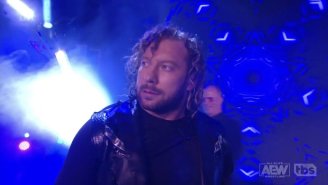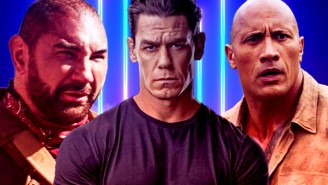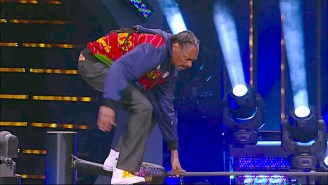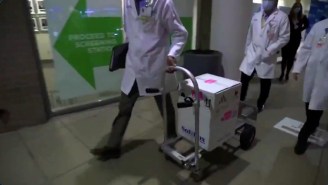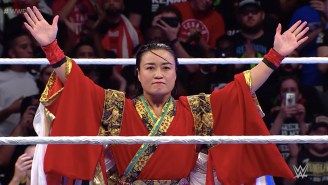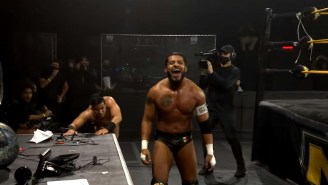Back in November, the wonderful and lovely Danielle let everyone know that AXS TV will be doing a 13-episode run of New Japan pro wrestling, with Canadian punsmith Mauro Ranallo and mixed martial artist Josh “The Warmaster” Barnett providing taped commentary. With the premier episode of NJPW coming up tonight, I figured it was appropriate to introduce Josh to the With Spandex audience to assuage any fears that he’s some random fighter with no background in pro wrestling.
In an interview with Wrestling Inc’s Raj Giri, Barnett details the beginning of his wrestling fandom:
When did you first become a wrestling fan?
Ever since I was a little kid. I grew up in a great era of professional wrestling. WWF was just really coming into it’s own. The start of WrestleManias, the legendary performers like Macho Man, Hulk Hogan, Honky Tonk Man, Iron Sheik, Sgt. Slaughter. The AWA was still around but there was talent that would go back and forth between the two. NWA wrestling was around, it was an awesome era to watch wrestling. Then of course the wars between WWF and WCW, which was pretty cool. Also, it became the era of tape trading and all this Japanese professional wrestling made its way over.
So you got in to Japanese wrestling fairy early?
Yeah, I was pretty interested in it because I was a big anime and Japanese fan. All this stuff was introduced to me through all these channels that need programming but don’t have the budget or the facilities to produce their own stuff. So they did the next best thing and go out and grab all this content, re-dub it, package it and sell it on the airwaves across the U.S., so I was already in to that kind of thing anyway– anything unusual or different. WWF at times had a pretty decent influx of Japanese talent like the Orient Express, the Jumping Bomb Angels, Hakushi, then there’s [Great] Muta and all of this talent going to WCW in their deal with New Japan. Seeing them pull out moves the American guys weren’t at the time, I just followed the bread crumbs back to Japan, mainly via tape trading.
Oh, yeah, that’s another thing about Barnett, he’s a giant anime fan. He’s said before his inspiration is Kenshiro from Fist of the North Star, so that’s what we’re dealing with here.
You started in MMA first, did you have interest at that time to get involved in pro wrestling?
It wasn’t something I thought about. I didn’t really know how one would break into that in the first place. I thought it was awesome, but I wouldn’t have even had an idea how to get involved. Luckily enough, a friend of mine was working for New Japan, so I contacted him and said “Dude, I really want to get in the ring and wrestle. Can you get me in touch with them?” He said it was no problem and told New Japan I was interested and it just set the wheels in motion. They approached me and set up everything from there on out and became way bigger than anything I ever thought it would be.
Did you have much pro wrestling training before your first match in New Japan?
None. I had not a single day of pro wrestling training. I spent two days working on a match with [Yuji] Nagata. A lot of that was him getting comfortable with what I could or couldn’t do, or did or didn’t know. I told him he could throw me any way he wanted. I already knew how to bump from Judo, I can suplex, I can do any half throw or submission from amateur wrestling, Greco, or fighting. So he’s like “lets take some wrist clutch exploders” and I’m like “whatever.”
I am definitely a coward, but I don’t think many people would be so nonchalant about taking wrist clutch exploders from Yuji Nagata on their first day of wrestling training.
Were you still fighting while you were wrestling for Inoki and New Japan?
Oh yeah, my first match was 2003. I came up with the idea that I’d like to fight as well as wrestle. They asked if I could do that, and I said I would reach out for fights here and there. I said I’d train any time I’m home and on tour, and I did every day. There’s a lot of training in New Japan. When we’d get to the arena Nagata would run us through conditioning drills. All of the Japanese wrestlers would get in a circle, count off 20 hindu squats and then move on. He would do 300 squats before he hit the ring that night. A lot of times we would grapple and wrestle, and I would actually teach a lot.
The person I probably taught the most was Liger, he trained with me almost every day. I also worked with Goto and Minoru, Nagata and Nakamura. I trained Nagata to fight. It was short notice but we did the best that we could. I worked with Nakanishi, anyone that wanted to get any kind of catch wrestling training I was there for. On the other end of that, Liger showed me a ton about working and selling in the ring. The Americans like Scott Norton, Christopher Daniels, Perry Saturn, Mike Barton (Bart Gunn), helped me a lot with pro wrestling culture and with learning how to work in the ring. Chono showed me how to hit ropes. Just every day picking something up, and chain wrestling with Nagata. I’m just absorbing everything, I’m constantly training in the ring, so I wanted to fight. On the road someone would hold pads for me, so I’m good. I had everything I needed.
Being molded from the ground up by Jushin Liger sounds like a good deal. Also, it’s pretty impressive when the worst guy to have a hand in your training is Bart Gunn.
Check out Josh’s thoughts about laying down commentary
In the second part of the interview, Josh spoke about his commentating gig:
You have the NJPW show on AXS [debuting this Friday]. When were you approached about this?
A couple of months ago. I don’t know if I was on their shortlist, but they just said they’d like for me to come do this. They asked if I was interested and I said I’d love to. Getting to work with Mauro Ranall was awesome because he’s one of my favorite MMA announcers. The show includes some of their best product over the last couple of years. It throws all of the casual fans in, and brings everybody up to speed for the future shows that will be more current and catch everybody up.
Josh also spoke with Between the Ropes about the New Japan job:
So what was your immediate reaction when you got the call about being part of the broadcast team for New Japan Pro Wrestling?
I was really excited about it. And honestly, I feel deep inside that there’s almost no one better to help call the action than myself, as a color person. But, then again, that kind of responsibility of being the guy that’s not only been a professional wrestler for over 11 years, but I started in New Japan Pro Wrestling. That’s where I learned my craft of ring generalship and professional wrestling. Also, I have a lot of intimate knowledge and details about some of the training and techniques and wrestling styles of some of the wrestlers we’d be talking about, so, would I be able to bring it up to task?
How much of the history do you bring into your broadcast style when you’re calling the matches?
Oh, quite a bit, especially whatever I think is pertinent. Because it’s one thing to watch what’s going on, move for move, and see how they’re battling in just a simple, visual, physical sense, but to help the fans understand why they might have gone for that move, or whether or not their next chain of events, was it a good idea or a bad idea? Or what this person is in terms of their mentality is as a person overall and how that plays into their wrestling style. How even some of their signature moves and physical attributes pair up against their opponents.
When you guys were doing the voice over for the shows, was there anything that [Mauro Ranallo] knew that you did not know that really surprised you, or vice versa?
I don’t doubt it, I really don’t. I think that I brought some surprising aspects of the whole New Japan Pro Wrestling company and its athletes, in that I knew all these intimate details of guys I used to train, people I’ve matched up against, all this personal stuff, that quite frankly, unless you were there, you really couldn’t have that.
I don’t know if I can handle commentary that will provide insight into a wrestler’s thinking. Let’s learn more about Josh’s time in NJPW:
You mentioned that you had started your pro wrestling career in New Japan back in 2003, what was it like to work for the group then, when you were just getting starting out in that business?
It was amazing. I felt like I was walking through the halls of storied legend. So many people had come through there, shooters, workers, didn’t matter, the best you’ve ever heard of, and some of the best some folks obviously hadn’t heard of, perhaps not until they watch this show. And getting the opportunity to work with the people that I did, and to learn from some of the people over there that I got the opportunity to was the kind of thing, stuff just has to line up at the right place at the right time, and you have to be willing and able to walk through that kind of a door for an opportunity of that level. And I’m really grateful for it.
As a person with functioning eyeballs, Josh also has high praise for the reigning King of Swag, Shinsuke Nakamura:
Yeah, you know, I remember when Nakamura was just a young boy, starting out in New Japan. But I can understand why they were so high on him in the first place. And I’ll admit, he is an odd character, even still, his results and abilities speak for itself. The guy had one of the most beautiful and fastest double leg takedowns in all MMA, and I’ve had the pleasure of training him as a fighter, and helping him grow in that aspect, and I’ve also had the pleasure of facing him in the ring, and watching him go out there and perform, at arguably one of the best levels in all of professional wrestling.
What was it like being in the ring with him?
You know, the thing about Nakamura is, while he’s grown into more physical attributes and more strengths in the athletic and move and physical sort of way, he’s always had a very keen mind. You always had to keep in mind, it didn’t matter if you were beating the crap out of him, if you allow one mistake, if you overlook him, he will come back and make you pay for it.
How much interaction did you have, or were you around Tanahashi and Okada?
Okada wasn’t there, he wasn’t in the company when I was. And Tanahashi, I didn’t have a whole lot of interaction, necessarily, but I knew him, we knew each other. I trained him some, as well as Toru Yano on a training trip out to the Inoki dojo, back in the day. Hard worker, and he’s not that bad of a boxer, at least, he didn’t used to be. Had a lot of capability in areas that people probably don’t really think of when they think of Tanahashi. I know he loves that straight-jacket German suplex, but he used to use a half-hatch, which is a very classic wrestling maneuver. He’s got a lot of scientific aspects to him if he wants to pull those out, but people are already aware of his high flying acrobatics and his penchant for going big.
It should be really cool to hear commentary from a guy who had even a tiny hand in the development of some of these incredible wrestlers.
Check out some of Josh’s most recent matches in Japan, both of which took place on the giant New Year’s Eve shows that Japan is famous for!
Vs Hideki Suzuki, IGF rules, 12/31/2011
Here’s a pretty standard, grappling heavy match between Barnett and Suzuki for a co-promoted DREAM and Inoki Genome Federation event. It’s mostly catch-as-catch can, but some suplexes do get thrown in towards the end.
Barnett & Naoya Ogawa Vs Kazuyuki Fujita & MINOWAMAN, Inoki Bom-Ba-Ye, 12/31/2014
Despite everyone in this contest being experienced mixed martial artists, this is a much more straight-forward pro wrestling tag match. Be sure to check out Josh screwing up a Figure Four attempt and asking the crowd to keep quiet about it.
Check out Josh Barnett and Mauro Ranallo providing commentary for New Japan Pro Wrestling on AXS TV starting tonight at 9:00 PM ET!

